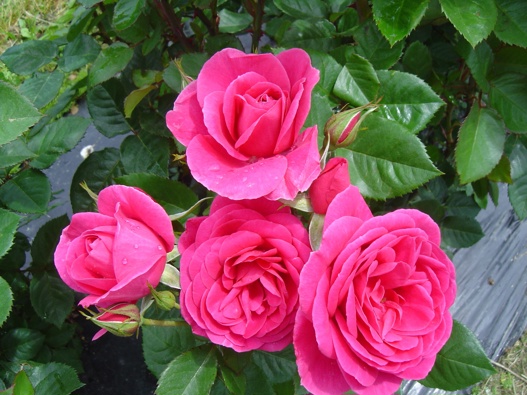Before you start pruning your roses (leave that till late June, July, August!) it might pay to go and have a look at the state of them:
Are they doing well in their current position?
Did they flower abundantly?
What was the state of diseases during the growing season? Black spot, Downy mildew, rust?
Just think about how much you’ll be pruning them in a month or two – how brutal will it be?
Do some roses need to move to a different place in the garden? If so: prepare that spot now.
They should have finished flowering by now and that means you can take cuttings of the ones you want to reproduce from, to either extend the rose garden or give away new plants
Tools: sharp and well-maintained secateurs, dipped in bleach/disinfectant to avoid disease transmission.
Select some decent, strong “canes” or branches that performed well and don’t show signs of plant disease; Always over-estimate the number of cuttings you’ll need because success rates vary from variety to variety
The cutting can be three to four “leaf nodes” long (Leaf nodes are the points where leaves come/came from.
Select some strong, pencil-thick canes and cut on an angle above the top node and make a straight cut under the bottom node. That way you can always tell “what’s up and what’s down”. It also lets the rain water run off the cutting quickly during showers, avoiding too long residual wetness on the cutting.
It may pay to scrape the bottom 2 cm of the cutting with a knife (wilfully “damaging” it) to encourage the cutting to form roots quicker.
Take off buds and leaves, remains of flower stalks are rose hips; you can leave the thorns on.
Cuttings go into a nice sandy, course, mix with some added organic matter or potting mix. This allows water to drain out quickly so that the roots don’t get affected by rots.
Yes – you could use some rooting hormone if you wish, although this is not always necessary at this time of the year – the stems are still quite able to send signals to the “wound” to grow some roots.
When the cuttings are in place, keep the pots or trays moist but not overly wet. We often have them in glass house or tunnel house, out of direct sunlight; they don’t need any fertiliser until the roots are well-established 6 months later (beginning of spring);
Some people plant them in garden soil too early… wait till the roots are a nicely-sized ball!
Good, well-drained soil is perfect for the new roses; organic material helps to retain moisture during dry summers and it holds on to nutrition (minerals and other useful plant-assisting chemicals)
To reduce plant diseases in roses it pays to space your roses well. It allows air movement to dry the plants after rainfall or “overhead” watering systems; a lot of rose diseases are transmitted through water droplets and by having rose plants wet for prolonged periods of time (prolonged infection periods!
Take your Radio, Podcasts and Music with you










